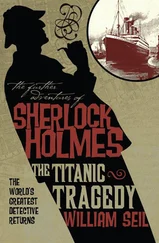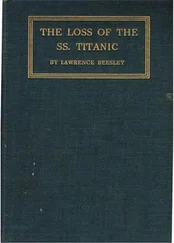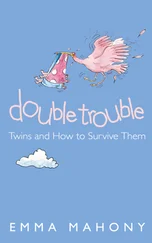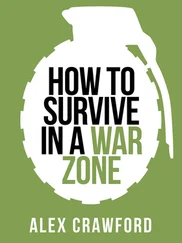‘It is the great Captain’, Smith said, ‘who doesn’t let things happen’, and for forty-three years nothing much had happened on any of his crossings. But latterly, over a period of eight months, he was responsible for two accidents and one near miss. The previous September the Olympic, while under his command, had rammed into the British cruiser, HMS Hawke; then in February he drove the Olympic over a submerged wreck and lost a propeller blade. Then leaving Southampton on 10 April, the Titanic narrowly missed crashing into the American liner, New York. ‘Had he been saved,’ the Washington Times commented on 17 April, ‘Captain Smith’s career was over. He had twice escaped the rule that the victim of an accident to a vessel must give up his post,’ and his preferential treatment by the White Star Line violated ‘a deep sea tradition to dispense with the services of officers in command of vessels that met with disaster’. 27
Captain Smith was sixty-two when he took command of the Titanic. It is often said that this was to be his last voyage before retirement, but he is unlikely to have stepped down at the point in his career where he was at his most assured, and the White Star Line would have been unwilling to let go of such an asset. If anything, Smith’s retirement began when the Olympic and Titanic were launched, at which point he relaxed on the job. ‘Either of these vessels could be cut in halves,’ he told a young officer, ‘and each half would remain afloat indefinitely.’ 28Like his first-class passengers, Smith was pampered, celebrated and over-confident — the very opposite of the stoical Captain Rostron, who at forty-two was beginning his career as a commander. Having trained as a cadet on the Mersey ship, the Conway, Rostron joined the Cunard company in 1895 and had been in command of the Carpathia, whose plain interior was described in a trade magazine as being ‘suggestive of good taste and solid comfort’, for three months. Slim, balding and religious, Rostron was praised after the rescue for his ‘unaffected valour’, his ‘own indifference to peril, his promptness and his knightly sympathy’. 29
As the ship’s chaplain held a service of thanksgiving and remembrance, Rostron ensured that the orders he had dispensed earlier that morning were being followed. While the second-class dining room was turned into a hospital for the injured and his own cabin prepared for the most elite of the first-class widows, including Mrs Thayer, the floors and tables of the first- and third-class dining rooms were cleared for further women to bed down and the smoking rooms converted into dormitories for the men. Meanwhile the Carpathia ’s women formed a relief committee to provide clothing for those who had arrived in their dressing gowns or evening wear, ship’s blankets were cut up to make warm coats for the children, and the first-class Titanic passengers formed a team of seven to care for those in steerage. Another committee of survivors raised $15,000 to help those who were too destitute to continue with their journeys. Not one of the Carpathia ’s passengers complained about the inconvenience caused to their cruise. One Titanic survivor said that she ‘had never seen or felt the benefits of such royal treatment’. In a letter to Walter Lord in 1954, Bertha Watt, who was a child when she was rescued, said that on the Carpathia ‘I learned a great deal of the fundamentals I have built a happy life on, such as faith, hope, and charity.’ 30Marie Young, a first-class survivor, described how the experience of ‘those who mingled freely in the ship’s company’ was ‘richer, by far’, than that of Ismay, alone on his bunk. Meanwhile, the Titanic crew, whose pay had stopped the minute the ship sank, waited for word from their employer, who had not yet emerged from his private cabin.
At 8 a.m., before being sedated by the Carpathia ’s doctor, Ismay had scribbled a Marconigram to Philip Franklin, American vice-president of the International Mercantile Marine, the parent company of the White Star Line:
Deeply regret advise you Titanic sank this morning after collision with an iceberg, resulting in serious loss of life. Further particulars later.
The message was written on the advice of Rostron, who described Ismay as ‘mentally very ill at the time’. So unable was Ismay to function, Rostron said, that ‘our purser asked him to add the last three words’. But Ismay did not send further particulars later, and nor was the Marconigram sent that day. Instead, it got buried under the mountain of messages from Titanic passengers which the exhausted operator, Harold Cottam, was trying to work his way through.
Philip Franklin, who claimed to know as little as everyone else about the fate of the Titanic and her passengers, did not receive Ismay’s official notice of the wreck until Wednesday morning, by which point it had been overtaken by a deluge of other messages. During the previous two days, the White Star Line and the press offices were receiving and repeating what the British Chronicle described as ‘an orgy of falsehood’ which began with a Marconigram from an unidentifiable source which Franklin and others received on Monday, informing him that everything was fine:
All Titanic passengers safe. The Virginian towing the liner into Halifax.
Delighted, Franklin arranged for a ship to meet the Titanic as she came into port, and a train to take her passengers on to New York. Two hours later he received another message from another unidentifiable source, this time saying that it was ‘reported’ from the Carpathia that:
All passengers of liner Titanic safely transferred to this ship and the SS Parisian. Sea Calm. Titanic being towed by Allan Liner Virginian to port. 31
Confused, Franklin ordered the train making its way to Halifax to turn around and come back again. The Titanic passengers would now be met, he assumed, in New York. The New York Sun felt able to run the headline ‘ALL SAVED FROM THE TITANIC’. It was only when David Sarnoff, a twenty-one-year-old Marconi operator, picked up a message from the Olympic that the truth was known:
Carpathia reached Titanic position at daybreak. Found boats and wreckage only. Titanic had foundered about 2.20 a.m. in 41.16 north, 50.14 west. All her boats accounted for. About 675 souls saved, crew and passengers included.
Sarnoff passed the information on to the Press Association, after which, in his own words, ‘Bedlam was let loose’. A second Marconigram from Captain Haddock of the Olympic read:
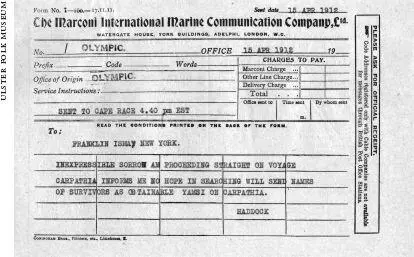
Yamsi was Ismay’s codename. Until that moment, Franklin said, ‘we considered the ship unsinkable, and it never entered our minds that there had been anything like a serious loss of life’. The New York Times then ran the headline: ‘MANAGER OF THE LINE INSISTED SHE WAS UNSINKABLE EVEN AFTER SHE HAD GONE DOWN’.
By Tuesday the names of survivors had begun to slowly trickle into the news offices, sent via the Olympic because the Carpathia had only a short-range wireless. Anguished crowds waited for news outside the White Star Offices in New York, Liverpool, Southampton and London, two wives of the crew dying from the shock and suspense. Word spread that Ismay was alive while other prominent men were not and that the Titanic had received, and ignored, several ice warnings. It was believed that the source of the reassuring Marconigrams received by Franklin, and also by Congressman J. A. Hughes — whose newly married daughter, Mrs Lucian P. Smith, had accused Ismay of demanding a private cabin on the Carpathia — was Ismay himself.
Читать дальше


